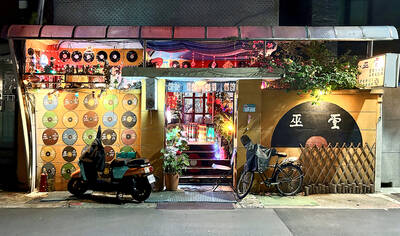The man at the next table plunks down two BlackBerrys on top of a stack of reports. He has the typical businessperson’s habit of peppering his Mandarin with English words like “finance,” “report” and “amazing de (的) performance.”
At Paul, the newly opened restaurant and bakery at Renai Circle, tuning out of neighboring diners’ conversations is difficult as the lunch and dinner crowds are made up of businesspeople and the dinning setup follows the French cafe tradition of placing tables just centimeters apart.
The French bakery and restaurant opened a few months back to much media fanfare, partially because most of Paul’s recipes use ingredients — no melamine here — sourced from France.
The restaurant has a banquette running along three walls and one six-seat table in the center and is crammed with two-person tables that can be pushed apart or together. The walls are painted a soothing autumnal yellow, and the small antique-style wall lights, Vermeer-like paintings and heavy curtains lend the place a rustic atmosphere. Large wooden beams crisscross the ceiling and complete the country farmhouse feel.
In keeping with the decor, the limited menu of quiches (NT$395), sandwiches (NT$385), salads (NT$385) and crepes (NT$385) is country-style cooking inspired by France. A la carte items can be ordered for takeout at the bakery.
While all items on the restaurant’s menu are set meals, which include main course, soup of the day and choice of coffee, tea or soft drink, items from the bakery can be ordered separately for dessert.
I went with the vegetarian quiche.
The mushroom soup arrived steaming hot in a small bowl just moments after it was ordered. The broth was creamy and full-flavored with generous chunks of freshly chopped mushrooms and topped with a thin baguette crouton.
The quiche was served on a large plate accompanied by a fresh garden salad tossed with red wine vinaigrette and thickly cut slices of baked tomato and zucchini. Swathed in olive oil and sprinkled with herbs, this accompaniment contrasted nicely with the heaviness of the quiche.
The quiche, held together with a rich and flaky pastry crust, which crumbled into pieces under a little pressure from my fork while the body still managed to retain its shape — a sign that Paul takes its pastry seriously — contained chunks of eggplant, zucchini and tomato. Hints of pesto and Parmesan added a complexity to the vegetables.
The portions at Paul tend toward the large and I didn’t have enough room to sample the wide array of pastries and desserts from the bakery next door. That will have to wait for another visit, which will likely be in the near future.— NOAH BUCHAN

The Lee (李) family migrated to Taiwan in trickles many decades ago. Born in Myanmar, they are ethnically Chinese and their first language is Yunnanese, from China’s Yunnan Province. Today, they run a cozy little restaurant in Taipei’s student stomping ground, near National Taiwan University (NTU), serving up a daily pre-selected menu that pays homage to their blended Yunnan-Burmese heritage, where lemongrass and curry leaves sit beside century egg and pickled woodear mushrooms. Wu Yun (巫雲) is more akin to a family home that has set up tables and chairs and welcomed strangers to cozy up and share a meal

Dec. 8 to Dec. 14 Chang-Lee Te-ho (張李德和) had her father’s words etched into stone as her personal motto: “Even as a woman, you should master at least one art.” She went on to excel in seven — classical poetry, lyrical poetry, calligraphy, painting, music, chess and embroidery — and was also a respected educator, charity organizer and provincial assemblywoman. Among her many monikers was “Poetry Mother” (詩媽). While her father Lee Chao-yuan’s (李昭元) phrasing reflected the social norms of the 1890s, it was relatively progressive for the time. He personally taught Chang-Lee the Chinese classics until she entered public

Last week writer Wei Lingling (魏玲靈) unloaded a remarkably conventional pro-China column in the Wall Street Journal (“From Bush’s Rebuke to Trump’s Whisper: Navigating a Geopolitical Flashpoint,” Dec 2, 2025). Wei alleged that in a phone call, US President Donald Trump advised Japanese Prime Minister Sanae Takaichi not to provoke the People’s Republic of China (PRC) over Taiwan. Wei’s claim was categorically denied by Japanese government sources. Trump’s call to Takaichi, Wei said, was just like the moment in 2003 when former US president George Bush stood next to former Chinese premier Wen Jia-bao (溫家寶) and criticized former president Chen

President William Lai (賴清德) has proposed a NT$1.25 trillion (US$40 billion) special eight-year budget that intends to bolster Taiwan’s national defense, with a “T-Dome” plan to create “an unassailable Taiwan, safeguarded by innovation and technology” as its centerpiece. This is an interesting test for the Chinese Nationalist Party (KMT), and how they handle it will likely provide some answers as to where the party currently stands. Naturally, the Lai administration and his Democratic Progressive Party (DPP) are for it, as are the Americans. The Chinese Communist Party (CCP) is not. The interests and agendas of those three are clear, but